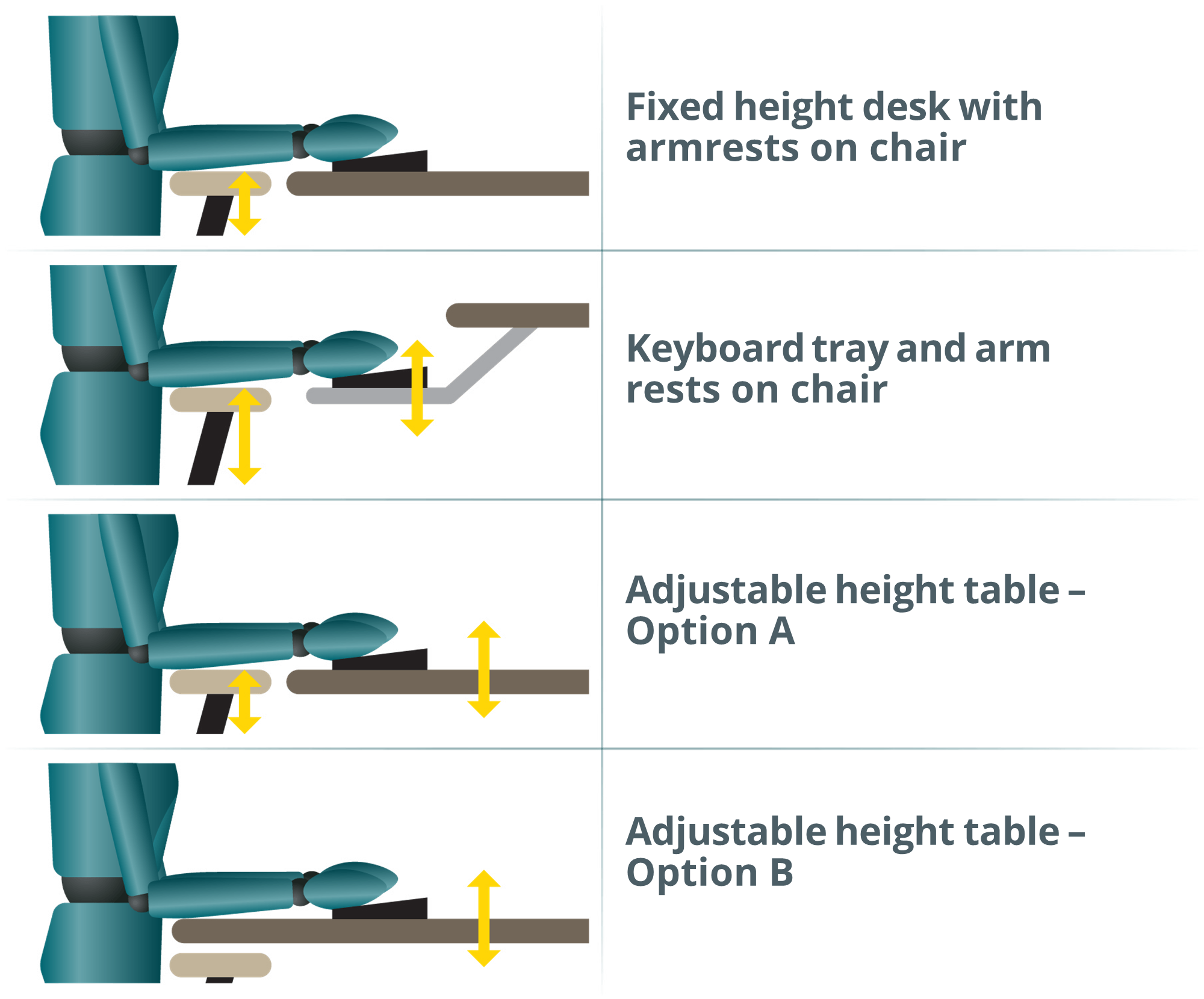Support the Arms
Quick Start Guide Office Poster 4

Support: Reduce fatigue by supporting your body!
Arms need support during keying and mousing. This lets the shoulders stay relaxed and the wrist and hands work in comfortable postures.
Different working postures need different types of support. Reduce fatigue by supporting the arms and shoulders by armrests, a keyboard tray, palm rests or the work surface.
Well-designed adjustable desks, chairs and equipment allow workers to move quickly and easily between different tasks and working positions.
Training on the adjustable features of the chair, workstation and equipment allows a worker to set it up to fit their body and the work they perform.
● Arms need support during keying and mousing to allow the shoulders to stay relaxed. The workstation should be set up so the shoulders are comfortable, the upper arm is relaxed and close to the side of the body and the wrist is in a comfortable position.
● Depending on the equipment available and the working postures chosen, support for the arms and shoulders may come from chair arm rests, a keyboard tray, palm rest or the work surface.
● Training on all of the adjustable features of the chair, workstation and equipment allows a worker to set it up to fit their body and the work they perform.
- Four common arm support situations:
- Fixed height desk with armrests on chair: armrests for fit and comfort. Now adjust the chair height so the armrest height is the same as the desk surface. If this isn’t possible, even with a foot-rest, a keyboard tray may help.
- Keyboard tray and arm rests on chair: Adjust chair height and armrests for fit and comfort. Then adjust keyboard tray height to armrest height: Rest the meaty part of the hand – not the wrist. Alternatively, remove “wrist rest” and use the support of the armrests. Note: Avoid or change keyboard trays with no room for mouse.
- Adjustable height table – Option A: After adjusting chair and armrests height for fit and comfort, adjust desktop height to arm rest height. Position keyboard and mouse close to edge of desk and use the support of the armrests, but don’t rest the wrists on the table edge.
- Adjustable height table – Option B: After adjusting the chair height for fit and comfort, adjust the desktop height to match elbow height. Push keyboard back about 30cm (12”) from front edge of desk. Move chair close to table. Rest the whole forearm on the table but avoid pressure on the elbows. Note: If armrests get in the way, lower them or swing them out of the way.
- All the parts of the workstation have to work together: After adjusting the individual parts of the workstation separately, fine-tune the setup so the workstation fits your body and tasks.
Include breaks and pauses at work
● Change it Up: Even with good furniture and equipment, doing a single task in a single position will create fatigue and discomfort.
● Changing tasks and moving between, sitting and standing, reclined sitting and walking helps avoid the negative effects of prolonged office work.
Fatigue creeps up on the body and eyes. Vary work and working positions. Move early – before you feel fatigue – and move often.
Stretching can help.
Mary's wrists and shoulders were hurting...
Mary’s wrists and shoulders were sore after a day’s work. This Quick Start Guide helped her understand the underlying problems:
Her desk was higher than her elbows. This meant that to use her keyboard and mouse, she had to hold her arms up and her elbows out from the side of her body leading to very tense shoulders.
Raising her chair height and supporting her feet on a footrest brought her armrest up to desk height and allowed her arms and shoulders to be relaxed. Mary could now work much more comfortably.
Improve work
- Ask yourself and others, “Why do people feel fatigued or sore when doing office work?” and keep asking “why” until you get a good answer!
- Once the underlying cause of the problem has been identified, employees and managers working together can control hazards and improve work best.
- Use these ideas for any office work, whether in an office building, home office, automobile or in the field.
